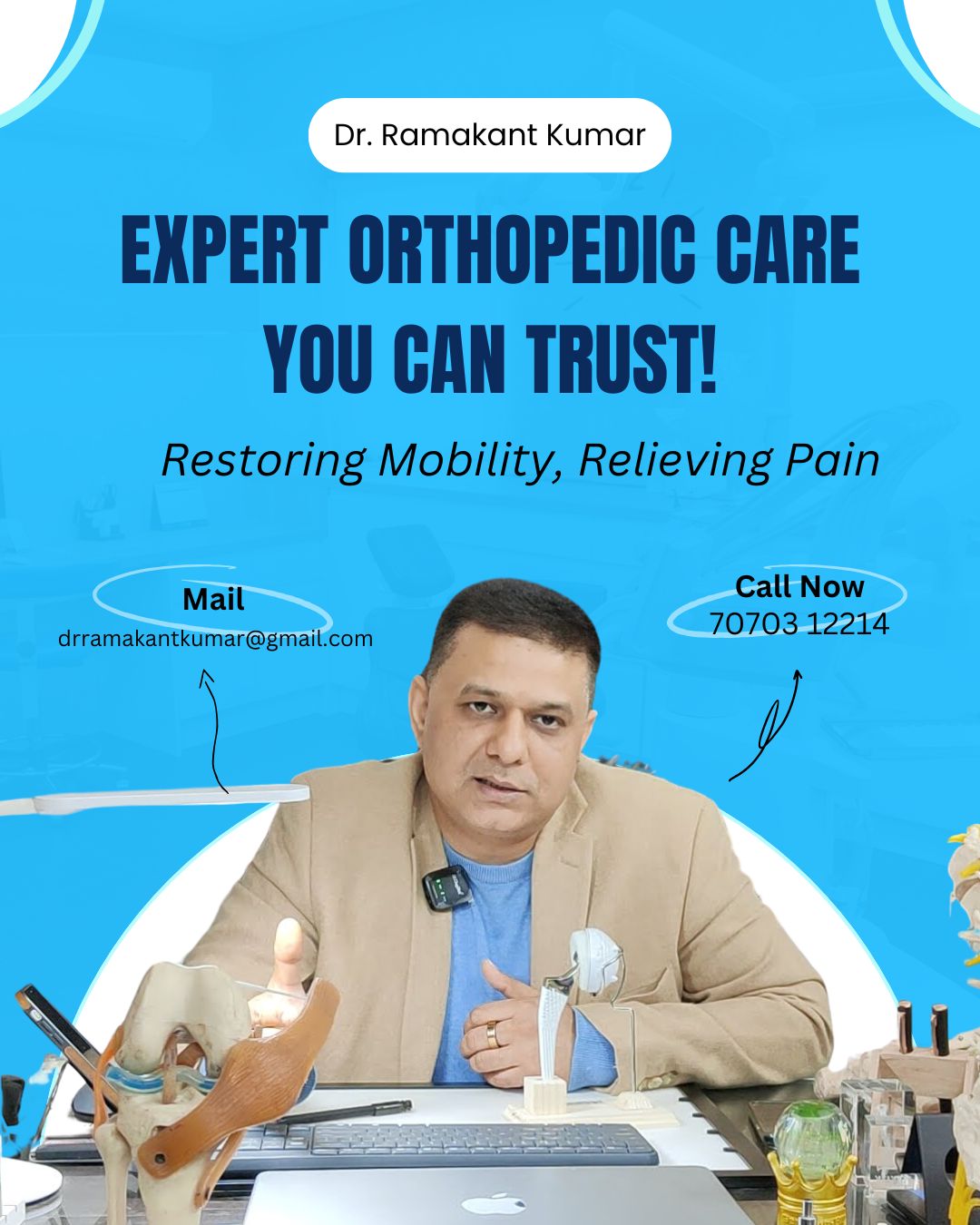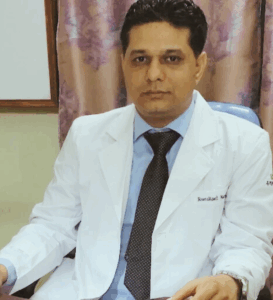Achilles tendinopathy, a condition affecting the Achilles tendon, is a common yet painful ailment that often troubles athletes, runners, and individuals with an active lifestyle.
The Achilles tendon, located at the back of the ankle, plays a crucial role in facilitating movement and transmitting the force generated by the calf muscles to the foot.
When this tendon becomes damaged or inflamed, it can lead to a range of symptoms that hinder mobility and cause discomfort.
In this discussion, we will delve into the intricacies of Achilles tendinopathy, exploring its causes, symptoms, risk factors, and How Do You Fix Achilles Tendinopathy and its impact on those affected by it.
If you already are facing Achilles Tendonitis and are looking for a sports or orthopedic specialist for the Treatment for Achilles Tendinopathy look no other than Dr. Ramakant Kumar.
Contents
Causes of Achilles Tendinopathy
Achilles tendinopathy, also known as Achilles tendonitis or Achilles tendonosis, is a condition that involves degeneration, inflammation, or damage to the Achilles tendon.
The Achilles tendon is a strong fibrous band of tissue that connects the calf muscles to the heel bone, allowing you to push off the ground while walking, running, or jumping.
While the exact cause of Achilles tendinopathy is not fully understood, several factors can contribute to its development. Here are some potential causes:
#1. Overuse or repetitive strain:
Overuse of the Achilles tendon is a common cause of tendinopathy.
Activities that involve repetitive stress on the tendon, such as running, jumping, or sudden increases in physical activity, can lead to microtrauma and subsequent degeneration of the tendon.
#2. Poor Biomechanics:
Abnormal foot or leg mechanics can increase stress on the Achilles tendon.
Factors such as flat feet (overpronation), high arches (supination), leg length discrepancies, or improper footwear can alter the normal distribution of forces and place additional strain on the tendon.
#3. Tight Calf Muscles:
Tightness or inflexibility in the calf muscles, particularly the gastrocnemius and soleus muscles, can limit ankle mobility and increase stress on the Achilles tendon.
This can occur due to inadequate stretching, improper warm-up or cool-down routines, or naturally tight muscles.
#4. Age-Related Degeneration:
As people age, the blood supply to the tendons decreases, and the tendon tissue becomes less elastic and more prone to injury.
This degenerative process can contribute to the development of Achilles tendinopathy, particularly in middle-aged and older individuals.
#5. Poor Training Techniques:
Incorrect training methods, such as sudden increases in training intensity, inadequate rest periods between workouts, or improper form during exercises, can strain the Achilles tendon and increase the risk of tendinopathy.
#6. Obesity:
Excess body weight can place additional stress on the Achilles tendon, increasing the likelihood of injury or degeneration.
#7. Pre-Existing Conditions:
Certain medical conditions, such as rheumatoid arthritis, gout, Psoriatic Arthritis, or diabetes, can affect the health of the Achilles tendon and contribute to the development of tendinopathy.
It’s worth noting that Achilles tendinopathy can be influenced by a combination of these factors, and the specific cause may vary from person to person.
If you suspect you have Achilles tendinopathy or are experiencing symptoms such as pain, swelling, or stiffness in the Achilles tendon area, it is recommended to consult with a healthcare professional for an accurate diagnosis and Treatment for Achilles Tendinopathy.
What Are Treatments for Achilles Tendonitis?
The Treatment for Achilles Tendinopathy, a condition characterized by pain and inflammation in the Achilles tendon, typically involves a combination of conservative measures and, in some cases, medical interventions.
Here are some commonly used treatment approaches:
#1. Rest and Activity Modification:
It’s important to avoid activities that aggravate the symptoms and give the tendon time to heal. This may involve reducing or modifying high-impact activities and sports that put excessive strain on the Achilles tendon.
#2. Ice Therapy:
Applying ice to the affected area for 15-20 minutes several times a day can help reduce pain and inflammation. Be sure to use a towel or cloth to protect the skin and prevent ice burns.
#3. Pain Management:
Over-the-counter nonsteroidal anti-inflammatory drugs (NSAIDs), such as ibuprofen, can help alleviate pain and reduce inflammation. However, it’s best to consult with a healthcare professional before taking any medication.
#4. Physical Therapy:
A physical therapist can develop an exercise program to strengthen and stretch the Achilles tendon, as well as the surrounding muscles.
Eccentric exercises, which involve controlled lengthening of the tendon, are commonly prescribed for Achilles tendinopathy.
#5. Orthotics and Footwear Modifications:
Wearing appropriate footwear with good arch support and cushioning can help relieve stress on the Achilles tendon. Orthotic devices, such as heel lifts or custom shoe inserts, may also be recommended to provide additional support.
#6. Extracorporeal Shockwave Therapy (ESWT):
This treatment for Achilles Tendinopathy involves the application of shockwaves to the affected area, promoting tissue healing and reducing pain. ESWT is often used for chronic cases that haven’t responded well to conservative measures.
#7. Corticosteroid Injections:
In some cases, corticosteroid injections may be used to reduce pain and inflammation in the Achilles tendon. However, these injections are generally used sparingly due to the potential risk of tendon weakening and rupture.
#8. Platelet-rich plasma (PRP) Therapy:
PRP therapy involves injecting a concentrated solution of the patient’s own platelets into the affected tendon. Platelets contain growth factors that can promote tissue healing and regeneration.
Who Treats Achilles Tendonitis?
It’s important to note that The Best Treatment for Achilles Tendonitis Is on the basis of the severity and duration of symptoms.
It’s recommended to consult with a healthcare professional, such as a sports medicine physician or orthopedic specialist, who can provide a proper diagnosis and develop an individualized treatment plan based on your specific condition.
Exercises for Achilles Tendonitis in Heel
Performing specific exercises for Treatment for Achilles Tendonitis in Heel can help strengthen and rehabilitate the Achilles tendon. Here are a few exercises that can be beneficial:
#1. Calf Raises:
Stand with your feet hip-width apart, holding onto a stable surface for support if needed. Slowly rise up onto your tiptoes, lifting your heels as high as possible.
Hold for a moment, then lower your heels back down to the starting position. Repeat for 2-3 sets of 10-15 repetitions.
#2. Eccentric Heel Drops:
Stand on a step or raised platform with the balls of your feet on the edge and your heels hanging off. Slowly lower your heels below the level of the step, allowing your Achilles tendon to stretch.
Hold the stretched position for a few seconds, then use your other foot or a wall for support to raise your heels back up to the starting position. Perform 2-3 sets of 10-15 repetitions.
#3. Towel Stretch:
Sit on the floor with your legs straight out in front of you. Place a towel or resistance band around the ball of your foot, holding onto both ends.
Gently pull the towel towards you, flexing your foot and feeling the stretch in your calf and Achilles tendon. Hold for 30 seconds, then relax. Repeat 3-4 times on each foot.
#4. Ankle Alphabet:
Sit in a chair or lie down on your back. Lift one leg off the ground and draw the alphabet letters in the air with your toes.
This exercise helps improve ankle mobility and strengthens the muscles around the Achilles tendon. Repeat with the other leg.
#5. Resistance Band Exercises:
Secure a resistance band around a sturdy object and loop it around the ball of your foot.
Sit on the floor with your legs straight out in front of you, and flex your foot back against the resistance of the band. Repeat for 2-3 sets of 10-15 repetitions on each foot.
Remember to start slowly and gradually increase the intensity and duration of these exercises as your Achilles tendon becomes stronger and more flexible.
If you experience pain or discomfort, it’s important to consult with a professional Orthopedic Doctor in Patna for an accurate diagnosis and tailored treatment plan.
Get in Touch With Dr. Ramakant Kumar – Orthopedic Specialist in Patna
Achilles tendinopathy is a challenging condition that requires patience and dedication to overcome.
By understanding the causes, seeking appropriate medical guidance, and adopting a comprehensive Treatment for Achilles Tendinopathy, individuals can regain strength and mobility in their Achilles tendon.
Remember, healing takes time, so stay committed to the recovery process and gradually reintroduce activities to prevent future injuries.
With perseverance and a focus on rehabilitation, you can conquer Achilles’s tendinopathy and return to a life of movement and vitality.




